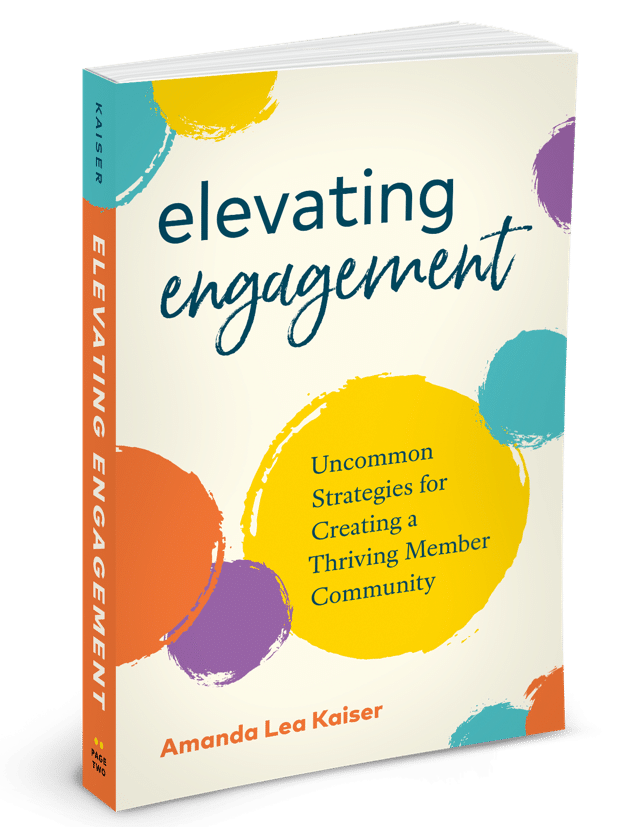Experience + Value = A New Formula for Successful Member Engagement

An interview with Amanda Lea Kaiser, author of “Elevating Engagement: Uncommon Strategies for Creating a Thriving Member Community.”
Ask 477 association professionals and members about engagement, and the answers differ. Real engagement isn’t about clicks, opens, registrations, or metrics; it is very human and very emotional, says #1 best-seeing author Amanda Lea Kaiser.

This interview with Kaiser has been edited for clarity and length.
In the opening pages of your book, you talk about today’s workforce: how association members have less time to do more work with tighter budgets, leaving little time for strategic thinking. Why is this important for association professionals to think about?
Kaiser: When you think about engagement as a member, whether attending a conference or reading a journal article, you need to carve out all of this time and pay attention to it. That’s really hard. People are running at a very frantic pace, meaning they feel they don’t have a lot of time, and they actually don’t have a lot of time. They have a really hard time devoting their attention to any one thing. We have a lot of competition for our time; when we look at engagement, we have to realize the way people feel about time and where they put their attention is changing, and that impacts engagement.
Who did you write this book for?
Kaiser: Everybody! All member-facing people in professional spaces, definitely CEOs and professional directors, membership, meetings, and IT staff. It applies to small associations and large associations. It’s for everybody because the membership department can’t do it alone. It’s a whole enterprise endeavor.
What is your book’s main takeaway message for this audience?
Kaiser: The main message is that every time you focus on value, think about the experience you are giving when delivering this value. When you write your new member welcome emails, what you say is the value, and how you say it is the tone. Can you warm up the tone? When they pick up their badge, can you give them a big, genuine smile?
Why should they do it?
Kaiser: Engagement is synonymous with value. There are two parts of engagement. One part is value, and the other part is experiences. The book focuses on the experiential part of it: how to lean into the experience part of engagement.
Why engagement? Why experiences?
Kaiser: I’ve read a lot of neuroscience recently, and there is a whole passel of new research that says that people make many of their decisions based on emotions. The decision to connect, affiliate, and belong are all very emotional decisions, and emotions drive experiences. There is a saying about organizational culture. All organizations have a culture. If you focus on it, you might create a great culture; if you don’t focus on it, it’s potluck. An organization’s culture is there, even if you don’t focus on it. The same goes for experiences. They happen whether you focus on them or not. So why not deliver value during those experiences?
What could happen if an association doesn’t start looking at engagement?
Kaiser: A lot of organizations focus on value. They might even be focused on the metrics of engagement. But what they might be missing is the experiential part of engagement. According to research, most organizations are average. But when I ask members to describe the ones that make them feel happy, what makes these organizations so great is the amazing value and positive experiences they create for their members.
Where is the best place in an organization to start to deliver amazing value and positive experiences?
Kaiser: Overall, if you have any doubts about where to start, start with new members. I did a New Member Engagement Study with my partners at Dynamic Benchmarking, and we found that the very best organizations used a handful of tactics. And the membership department does not own these tactics, they are owned by all departments in the association.
Can you share some of the tactics you wrote about in your book?
Kaiser: One of the popular tactics is onboarding new members through an online community, and the online community might be a collaboration between the marketing and IT departments. Assign a member to serve as an experience ambassador. These ambassadors serve to create positive experiences by spotting interesting conversations and keeping the conversation going with well-placed answers and questions.
Online communities seem to be taking off as a place for members to network and engage. What do you think about this space? Do you have any advice for an association looking at these platforms and how to use them best?
Kaiser: I love online communities. They give everyone the ability to connect and learn. If you use the value plus experiences formula, implementing the platform and allowing people to share and connect is the value. The experience side of the community is how it is monitored or curated. Leaders can model the behavior they want to see. And you can assign chat ambassadors to create a positive community culture. What you are trying to create is an environment that is so vibrant that members feel compelled to jump in and share their knowledge; they are not afraid to ask a question, even a question that might be perceived as a stupid question, because they know that the community members have their backs.
Your book maps out a member’s journey in an association in six categories. What advice would you give an association looking to start focusing on engagement? Is there one category that is a must?
Kaiser: Always begin at the top of the journey when a new member is in the observe and assess stages. When I asked association professionals in the New Member Engagement Study what worries them most about new members, 71% of the 307 associations said how many new members join but never use their benefits. Slow and steady wins the race. The longer a new member program runs, the better its effectiveness. A comfortable growth cadence may be that you try an email series in year one. Then, buoyed by good results, implement another tactic. By year three, your program might have three or four well-performing tactics.
When should someone start looking at their engagement? Is there a better or worse time? Should it be during the strategic planning cycle?
Kaiser: Anyone in the organization who wants to can start offering members a better experience anytime. You don’t need the board or your boss’s approval to offer great experiences, and you don’t need money. Start integrating little experiments and see what happens. Anytime is the right time.
You call yourself a connoisseur of experiences? How does focusing on experiences drive membership, meeting attendance, loyalty?
Kaiser: I’m on a mission to make everyone CEO a chief experience officer. One of the things I do as a chief experience officer is reflect every time I have a great experience; I’ll take notice, and then I’ll deconstruct in my mind what made that a good experience and how to apply it to an association member experience.
In bringing out this idea that value plus experiences equals robust member engagement, Kaiser encourages everyone in an association to wear the hat of CEO — chief experience officer – and add three to five tactics to their work with members. Each of these tactics functions as an opportunity for associations to hop on the experience trend and direct it to their own ends. Those associations seeking to remain relevant, necessary, and forward-thinking in a busy world will heed Amanda’s advice and focus on value plus positive experiences.
In the end, it’s all about each one of us. As we evolve and educate ourselves as association professionals, we will seek to create and perfect an energetic environment where everyone feels accepted, respected, and heard.
Tags
Related Articles
Report Reveals Strategies to Overcome Membership Decline
McKinley Advisors’ Membership Reset report provides a roadmap that association leaders can use to refocus...
Member Retention: More Than Just a Number
Learn how the AANA used humor and multichannel marketing to win back lapsed members.
Building Tomorrow: HACIA’s Member Development Initiatives Are Reshaping the Construction Industry
Jacqueline Gomez, Executive Director of the Hispanic American Construction Industry Association (HACIA), describes the crucial...




